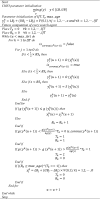Automatic detection and prediction of COVID-19 in cough audio signals using coronavirus herd immunity optimizer algorithm
- PMID: 39824893
- PMCID: PMC11742063
- DOI: 10.1038/s41598-025-85140-w
Automatic detection and prediction of COVID-19 in cough audio signals using coronavirus herd immunity optimizer algorithm
Abstract
The global spread of COVID-19, particularly through cough symptoms, necessitates efficient diagnostic tools. COVID-19 patients exhibit unique cough sound patterns distinguishable from other respiratory conditions. This study proposes an advanced framework to detect and predict COVID-19 using deep learning from cough audio signals. Audio data from the COUGHVID dataset undergo preprocessing through fuzzy gray level difference histogram equalization, followed by segmentation with a U-Net model. Key features are extracted via Zernike Moments (ZM) and Gray Level Co-occurrence Matrix (GLCM). The Enhanced Deep Neural Network (EDNN), tuned by the Coronavirus Herd Immunity Optimizer (CHIO), performs final prediction by minimizing error metrics. Comparative simulation results reveal that the proposed EDNN-CHIO model improves MSE by 25.35% and SMAPE by 42.06% over conventional models like PSO, WOA, and LSTM. The proposed approach demonstrates superior error reduction, highlighting its potential for effective COVID-19 detection.
Keywords: COVID-19 detection and prediction; Coronavirus herd immunity optimizer; Cough audio signals; Enhanced deep neural network.
© 2025. The Author(s).
Conflict of interest statement
Declarations. Competing interests: The authors declare no competing interests.
Figures

















Similar articles
-
CovidCoughNet: A new method based on convolutional neural networks and deep feature extraction using pitch-shifting data augmentation for covid-19 detection from cough, breath, and voice signals.Comput Biol Med. 2023 Sep;163:107153. doi: 10.1016/j.compbiomed.2023.107153. Epub 2023 Jun 8. Comput Biol Med. 2023. PMID: 37321101 Free PMC article.
-
Design and development of hybrid optimization enabled deep learning model for COVID-19 detection with comparative analysis with DCNN, BIAT-GRU, XGBoost.Comput Biol Med. 2022 Nov;150:106123. doi: 10.1016/j.compbiomed.2022.106123. Epub 2022 Oct 3. Comput Biol Med. 2022. PMID: 36228465 Free PMC article.
-
A novel adaptive cubic quasi-Newton optimizer for deep learning based medical image analysis tasks, validated on detection of COVID-19 and segmentation for COVID-19 lung infection, liver tumor, and optic disc/cup.Med Phys. 2023 Mar;50(3):1528-1538. doi: 10.1002/mp.15969. Epub 2022 Oct 6. Med Phys. 2023. PMID: 36057788 Free PMC article.
-
Past and Trends in Cough Sound Acquisition, Automatic Detection and Automatic Classification: A Comparative Review.Sensors (Basel). 2022 Apr 10;22(8):2896. doi: 10.3390/s22082896. Sensors (Basel). 2022. PMID: 35458885 Free PMC article. Review.
-
Respiratory Diseases Diagnosis Using Audio Analysis and Artificial Intelligence: A Systematic Review.Sensors (Basel). 2024 Feb 10;24(4):1173. doi: 10.3390/s24041173. Sensors (Basel). 2024. PMID: 38400330 Free PMC article.
References
-
- Abeyratne, U. R., Swarnkar, V., Setyati, A. & Triasih, R. Cough sound analysis can rapidly diagnose childhood pneumonia. Ann. Biomed. Eng.41(11), 2448–2462 (2013). - PubMed
-
- Botha, G. H. R. et al. Detection of tuberculosis by automatic cough sound analysis. Physiol. Meas.39(4), 045005. 10.1088/1361-6579/aab6d0 (2018). - PubMed
MeSH terms
LinkOut - more resources
Full Text Sources
Medical

